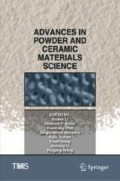Abstract
Hardystonite is currently recognized as a biocompatible bio-ceramic material for a range of medical applications. In this study, pure nanocrystalline hardystonite powder was prepared by mechanochemical synthesis of zinc oxide, silicate oxide, and egg shell in a planetary ball mill followed by sintering. It was found that pure nanocrystalline hardystonite powder formation occurred following 20 h of milling and subsequent sintering at 1000 ℃ for 3 h. Hardystonite scaffold was prepared by space holder method. The results showed that 3D porous scaffolds with pore sizes in the range of 200–300 μm, total and open porosity of 81 and 76%, respectively, with compressive strength and modulus of 0.35 and 10.49 MPa, were obtained. The average crystallite size of the prepared hardystonite powder and scaffold was measured to be 28 ± 3 and 79 ± 1 nm, respectively. The bioactivity of prepared scaffold was evaluated by simulated body fluid (SBF). Considering the results obtained, it seems that, manufactured scaffolds could be a good candidate for bone tissue engineering applications.
Access this chapter
Tax calculation will be finalised at checkout
Purchases are for personal use only
References
Burg KJL, Porter S, Kellam JF (2000) Biomaterial developments for bone tissue engineering. Biomaterials 21:2347–2359
Shirtliff VJ, Hench LL (2003) Bioactive materials for tissue engineering regeneration and repair. J Mater Sci 38:4697–4707
Roohani-Esfahani SI, Dunstan CR, Davies B, Pearce S, Williams R, Zreiqat H (2012) Repairing a critical-sized bone defect with highly porous modified and unmodified baghdadite scaffolds. Acta Biomater 8:4162–4172
Ghomi H, Emadi R, javanmard SH (2016) Fabrication and characterization of nanostructure diopside scaffolds using the space holder method: effect of different space holders and compaction pressures. Mater Des 91:193–200
Sadeghzade S, Emadi R, Ghomi H (2015) Mechanical alloying synthesis of forsterite-diopside nanocomposite powder for using in tissue engineering. Ceram Silik 59:1–5
Epple M (2018) Review of potential health risks associated with nanoscopic calcium phosphate. Acta Biomater 77:1–14
Hafezi M, Nezafati N, Nadernezhad A, Ghazanfari SMH, Sepantamehr M (2014) Bioinorganics in bioactive calcium silicate ceramics for bone tissue repair: bioactivity and biological properties. Ceram Sci Technol 5:1–12
Sadeghzade S, Emadi R, Tavangarian F (2016) Combustion assisted synthesis of hardystonite nanopowder. Ceramic Int 42:14656–14660
Wu C, Ramaswamy Y, Zreiqat H (2010) Porous diopside (CaMgSi2O6) scaffold: a promising bioactive material for bone tissue engineering. Acta Biomater 6:2237–2245
Wu C, Chang J, Zhai W (2005) A novel hardystonite bioceramic: preparation and characteristics. Ceram Int 31:27–31
Zreiqat H, Ramaswamy Y, Wu C, Paschalidis A, Lu Z, Birke O, Mcdonald M, Little D, Dunstan CR (2010) The incorporation of strontium and zinc into a calcium-silicon ceramic for bone tissue engineering. Biomaterials 31:3175–3184
Wang G, Lu Z, Dwarte D, Zreiqat H (2012) Porous scaffolds with tailored reactivity modulate in-vitro osteoblast responses. Mater Sci Eng, C 32:1818–1826
Sadeghzade S, Emadi R, Labbaf S (2016) Formation mechanism of nano-hardystonite powder prepared by mechanochemical synthesis. Adv Powder Technol 27(5):2238–2244
Gheisari H, Karamian E, Abdellahi M (2015) A novel hydroxyapatite- hardystonite nanocomposite ceramic. Ceram Int 41:5967–5975
Sadeghzade S, Emadi R, Tavangarian F, Naderi M (2017) Fabrication and evaluation of silica-based ceramic scaffolds for hard tissue engineering applications. Mater Sci Eng, C 71:431–438
Bohner M, Lemaitre J (2009) can bioactivity be tested in vitro with sbf solution? Biomaterials 30:2175–2179
Tavangarian F, Emadi R (2010) Mechanochemical synthesis of single phase nonocrystalline forsterite powder. Int J Mod Phys B 24:343–350
Sadeghzade S, Emadi R, Labbaf S (2017) Hardystonite-diopside nanocomposite scaffolds for bone tissue engineering applications. Mater Chem Phys 202:95–103
Soundrapandian C, Datta S, Kundu B, Basu D, Sa B (2010) Porous bioactive glass scaffolds for local drug delivery in osteomyelitis: development and in vitro characterization. Am Assoc Pharm Sci 11:1675–1683
Author information
Authors and Affiliations
Corresponding author
Editor information
Editors and Affiliations
Rights and permissions
Copyright information
© 2020 The Minerals, Metals & Materials Society
About this paper
Cite this paper
Sadeghzade, S., Emadi, R., Tavangarian, F. (2020). Synthesis of Silicate Zinc Bioceramic via Mechanochemical Technique. In: Li, B., et al. Advances in Powder and Ceramic Materials Science. The Minerals, Metals & Materials Series. Springer, Cham. https://doi.org/10.1007/978-3-030-36552-3_15
Download citation
DOI: https://doi.org/10.1007/978-3-030-36552-3_15
Published:
Publisher Name: Springer, Cham
Print ISBN: 978-3-030-36551-6
Online ISBN: 978-3-030-36552-3
eBook Packages: Chemistry and Materials ScienceChemistry and Material Science (R0)

